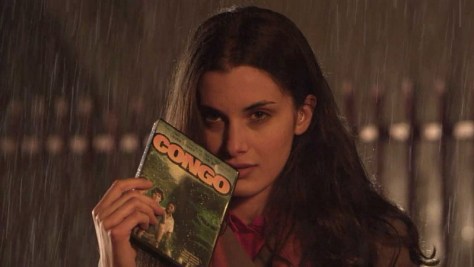
Format: Dual Format (DVD + Blu-ray)
Release date: 26 September 2016
Distributor: BFI
Director: Don Sharp
Writers: Julian Zimet, Arnaud d’Usseau
Cast: George Sanders, Beryl Reid, Nicky Henson
UK 1973
90 mins
The unlikely mix of black magic, undead bikers and Safeway makes this 70s British oddity endurably appealing.
‘Deep shame,’ was how Nicky Henson characterised his feelings about this suis generis exploitation weirdie, when quizzed by Matthew Sweet, but really, though the lovable thespian has obviously had great moments on stage, this is the one he’ll be remembered for. Witchfinder General is the superior film, but it’s not really a Nicky Henson film. Psychomania, God bless it, despite top-lining oldsters George Sanders and Beryl Reid, is Nicky Henson’s film, whether he wants it or not.
As if cobbled together from a fever dream about The Wild One and Polanski’s Macbeth, the film combines black magic and biker gangs, stone circles and juvenile delinquency. The script is by the same duo of blacklisted Americans who wrote Horror Express, and it has the same rather appealing mixture of strange, vaguely clever ideas, goofball nonsense and bizarrely naive exploitation elements. I wish the pair had written a whole bunch more horror films: they had a unique sensibility.
Genre specialist / all-rounder Don Sharp directs ably, starting the film rather brilliantly with slomo cyclists roving round a set of papier mâché megaliths on a misty morning, with John Cameron’s sonorous wacka-wacka score adding a kind of camp solemnity. Sharp had an affinity for overcranking, opening his Curse of the Fly (1965), a belated sequel to the Hollywood teleportation horror, with a surprisingly atmospheric, oneiric nocturnal chase, shot at around 48 fps. He’d also made Witchcraft (1964) with Lon Chaney Jnr. as an unlikely English warlock, and Hammer romps Kiss of the Vampire (1963) and Rasputin: The Mad Monk (1966), as well as the first two of Christopher Lee’s Fu Manchu outings.
Henson plays the biker son of medium Beryl Reid who acquires the power to come back from the dead through a mysterious ritual involving a frog (don’t ask). Sanders plays a butler who might be Satan, or something (I wasn’t totally clear: see what you think). Soon, Henson, looking damned good in his leather trousers, is converting his whole gang to an afterlife of mayhem, running amok in a Walton-on-Thames branch of Safeway.
The film’s take on youth culture is wonderfully peculiar: the bikers bury their leader on his bike in the stone circle to the tune of a folk song strummed on acoustic guitar; the gang wear crocheted waistcoats; nobody smokes (the producers were afraid they wouldn’t be able to sell the film to TV); nobody swears. But they run over a baby in a pram, and that was considered perfectly OK.
The violence and criminality is still slightly shocking, maybe because all the surrounding action is so absurd. The bikers are the main characters, and they will keep killing people. Elsewhere, there is amusing dialogue: ‘Abby’s dead.’ ‘You must be very happy.’ ‘I’ve always fancied driving through a brick wall.’ But then the movie will alternate pathetic, puerile hi-jinks (spanking a young mother in a hot-pants one-piece) with cold-blooded murder. The two tones only come together as black comedy during the impressive stunt sequences where the bikers commit suicide in order to rise again.
Rumours that old pro Sanders killed himself in response to seeing a print of this, his final movie, are doubtless false. The old rogue had gotten himself involved in a crooked business venture, hilariously called Cadco, and was facing possible financial ruin and legal proceedings, a likelier motivation for suicide than either a bizarre horror film or boredom, the cause cited in his note. And after all, the man had already worked for Jess Franco.
Scattered throughout Psychomania are familiar faces from TV shows like All Creatures Great and Small, Eastenders and Dad’s Army, with everyone managing to appear perfectly earnest and, in Henson’s case, actually cool, even though his character is a colossal jerk. The leftist writers appear to have had some kind of critique of youth culture in mind: Henson’s undead cyclist espouses a plan to kill every policeman, judge and teacher in the land, but once back on his bike, he always seems to gravitate back to Safeway.
David Cairns





